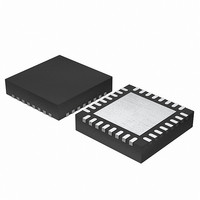EFM32G200F16 Energy Micro, EFM32G200F16 Datasheet - Page 85

EFM32G200F16
Manufacturer Part Number
EFM32G200F16
Description
MCU 32BIT 16KB FLASH 32-QFN
Manufacturer
Energy Micro
Series
Geckor
Datasheets
1.EFM32G200F16.pdf
(63 pages)
2.EFM32G200F16.pdf
(10 pages)
3.EFM32G200F16.pdf
(463 pages)
4.EFM32G200F16.pdf
(136 pages)
Specifications of EFM32G200F16
Core Processor
ARM® Cortex-M3™
Core Size
32-Bit
Speed
32MHz
Connectivity
EBI/EMI, I²C, IrDA, SmartCard, SPI, UART/USART
Peripherals
Brown-out Detect/Reset, DMA, POR, PWM, WDT
Number Of I /o
24
Program Memory Size
16KB (16K x 8)
Program Memory Type
FLASH
Ram Size
8K x 8
Voltage - Supply (vcc/vdd)
1.8 V ~ 3.8 V
Data Converters
A/D 4x12b, D/A 1x12b
Oscillator Type
External
Operating Temperature
-40°C ~ 85°C
Package / Case
32-VQFN Exposed Pad
Processor Series
EFM32G200
Core
ARM Cortex-M3
Data Bus Width
32 bit
Data Ram Size
8 KB
Interface Type
I2C, UART
Maximum Clock Frequency
32 MHz
Number Of Programmable I/os
24
Number Of Timers
2
Operating Supply Voltage
1.8 V to 3.8 V
Maximum Operating Temperature
+ 85 C
Mounting Style
SMD/SMT
Minimum Operating Temperature
- 40 C
Lead Free Status / RoHS Status
Lead free / RoHS Compliant
Eeprom Size
-
Lead Free Status / Rohs Status
Details
- EFM32G200F16 PDF datasheet
- EFM32G200F16 PDF datasheet #2
- EFM32G200F16 PDF datasheet #3
- EFM32G200F16 PDF datasheet #4
- Current page: 85 of 463
- Download datasheet (8Mb)
10.3.1.4 EM3
10.3.1.5 EM4
10.3.2 Entering a Low Energy Mode
10.3.3 Leaving a Low Energy Mode
2010-09-06 - d0001_Rev1.00
• The low frequency oscillator and clock trees are active
• Low frequency peripheral functionality (RTC, Watchdog, LCD, LEUART, I
• Wakeup through peripheral interrupt or asynchronous pin interrupt
• RAM and register values are preserved
• Both high and low frequency oscillators and clock trees are inactive
• Wakeup through asynchronous pin interrupts, I
• Watchdog enabled when 1 kHz clock has been selected
• All other peripheral functionality is disabled
• RAM and register values are preserved
• All oscillators and regulators are inactive
• RAM and register values are not preserved
• Wakeup from external pin reset
A low energy mode is entered by first configuring the desired Energy Mode through the EMU_CTRL
control register and the SLEEPDEEP bit in the Cortex-M3 System Control Register, see Table 10.2 (p.
85) . A Wait For Interrupt (WFI) or Wait For Event (WFE) instruction from the Cortex-M3 triggers the
transition into a low energy mode.
The transition into a low energy mode can optionally be delayed until the lowest priority Interrupt Service
Routine (ISR) is exited, if the SLEEPONEXIT bit in the Cortex-M3 System Control Register is set.
Entering the lowest energy mode, EM4, is done by writing a sequence to the EM4CTRL bitfield in
the EMU_CTRL register. Writing a zero to the EM4CTRL bitfield will restart the power sequence.
EM2BLOCK prevents the EMU to enter EM2 or lower, and it will instead enter EM1.
EM3 is equal to EM2, except that the LFACLK/LFBCLK are disabled in EM3. The LFACLK/LFBCLK
must be disabled by the user before entering low energy mode.
The EMVREG bit in EMU_CTRL can be used to prevent the voltage regulator from being turned off in
low energy modes. The device will then essentially stay in EM1 when entering a low energy mode.
Table 10.2. EMU Entering a Low Energy Mode
(‘x’ means don’t care)
In each low energy mode a selection of peripheral units are available, and software can either enable or
disable the functionality. Enabled interrupts that can cause wakeup from a low energy mode is shown
in Table 10.3 (p. 86) . Additionally, any reset source will return to EM0.
Low Energy Mode
EM1
EM2
EM4
available
EM4CTRL
0
0
Write sequence:
2, 3, 2, 3, 2, 3, 2,
3, 2
EMVREG
x
0
x
...the world's most energy friendly microcontrollers
2
85
C address recognition or ACMP edge interrupt
EM2BLOCK
x
0
x
SLEEPDEEP
0
1
x
2
www.energymicro.com
C, LETIMER, PCNT) is
Cortex-M3
Instruction
WFI or WFE
WFI or WFE
x
Related parts for EFM32G200F16
Image
Part Number
Description
Manufacturer
Datasheet
Request
R

Part Number:
Description:
KIT STARTER EFM32 GECKO
Manufacturer:
Energy Micro
Datasheet:

Part Number:
Description:
KIT DEV EFM32 GECKO LCD SUPPORT
Manufacturer:
Energy Micro
Datasheet:

Part Number:
Description:
BOARD PROTOTYPING FOR EFM32
Manufacturer:
Energy Micro
Datasheet:

Part Number:
Description:
KIT DEVELOPMENT EFM32 GECKO
Manufacturer:
Energy Micro
Datasheet:

Part Number:
Description:
MCU, MPU & DSP Development Tools TG840 Sample Kit
Manufacturer:
Energy Micro
Datasheet:

Part Number:
Description:
MCU, MPU & DSP Development Tools TG Starter Kit
Manufacturer:
Energy Micro
Datasheet:

Part Number:
Description:
MCU, MPU & DSP Development Tools TG108 Sample Kit
Manufacturer:
Energy Micro

Part Number:
Description:
MCU, MPU & DSP Development Tools TG210 Sample Kit
Manufacturer:
Energy Micro
Datasheet:

Part Number:
Description:
MCU, MPU & DSP Development Tools TG822 Sample Kit
Manufacturer:
Energy Micro
Datasheet:

Part Number:
Description:
MCU, MPU & DSP Development Tools TG230 Sample Kit
Manufacturer:
Energy Micro

Part Number:
Description:
SAMPLE KIT (SMALL BOX - CONTAINING 2 DEVICES)
Manufacturer:
Energy Micro

Part Number:
Description:
SAMPLE KIT (SMALL BOX - CONTAINING 2 DEVICES)
Manufacturer:
Energy Micro










